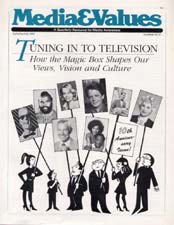CHILDREN: Learning to Decipher TV Culture
|
This article originally appeared in Issue# 40-41
|
How many two-year-olds do not know Big Bird or can't recognize the Golden Arches? Speaking, listening, writing! reading, and watching television have been said to be the three major forms of communication in Western societies. Of the three, most young children learn to watch television first.
The images of childhood television broadcasts remain with them as central parts of their childhood memories. In this way, television has been said to define generational subgroups in the culture, spanning socioeconomic status, geographic location or intellectual ability.
Although television is a central form of communication, few children are trained to be literate in that medium. They are taught reading, writing, and speech, but not TV production techniques and special effects, the methods and impacts of advertising, and responsible viewing habits. Those are precisely the skills that have been shown to counteract the negative
So what can parents, teachers and others who care about young children do? First, take advantage of the ability of television to unite children across geographic and social barriers. Use allusions to current programs to create a common reference point among children from different backgrounds. But move beyond the broadcasts themselves. Have children speculate how TV characters might react in situations that have never been represented on the program and talk about how "real life" is different from that character's experience.
Your participation can help children realize that they have ties with one another beyond their common media history. Talk about how common feelings, abilities, and successes and failures unite human beings, whether or not they have seen Pee-wee Herman on Saturday morning TV.
Finally, teach children about television as a medium. Watch with them and have them watch with each other. Have them keep logs of their viewing. Those logs could include anything from the number of hours they or other family members watch TV to the number of commercials selling particular products to the number of times one person hits another. Help children become aware of how television communicates. Teach them the grammar, syntax and punctuation of spoken language. Considering the position that television is likely to hold in their lives, such instruction is only logical.



